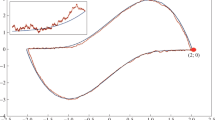Abstract—This paper considers the problem of synchronization in information transmission systems that use noiselike signals based on linear recurrent sequences (LRSs). For a model of a sequence of characters we use an approach associated with the representation of an LRS as a Markov chain. Radio access systems use synchronization for pilot sequences based on LRSs, which can be received using the algorithms described in this paper. The paper is devoted to the synthesis of quasi-incoherent recurrent LRS-filtration algorithms; the results of their statistical simulation are presented.




Similar content being viewed by others
REFERENCES
A. I. Alekseev et al., Theory and Application of Pseudorandom Signals (Nauka, Moscow, 1969) [in Russian].
L. E. Varakin, Communication Systems with Noise-Type Signals (Radio i Svyaz’, Moscow, 1985) [in Russian].
R. C. Dixon, Spread Spectrum Systems (Wiley, New York, 1976; Svyaz’, Moscow, 1979).
V. I. Ipatov, Wideband Systems and Code Division of Signals (Tekhnosfera, Moscow, 2007) [in Russian].
V. I. Borisov, V. M. Zinchuk, A. E. Limarev, and V. I. Shestopalov, Noise Immunity of Systems of the Radio Communication with Expansion of the Range with Direct Modulation by the Pseudorandom Sequence, Ed. by V. I. Borisov (RadioSoft, Moscow, 2011) [in Russian].
I. M. Teplyakov, B. V. Roshchin, A. I. Fomin, and V. A. Veitsel’, Radio Systems of Information Transfer (Radio i Svyaz’, Moscow, 1982) [in Russian].
V. I. Zhuravlev, Search and Synchronization in Broadband Systems (Radio i Svyaz’, Moscow, 1986) [in Russian].
E. P. Petrov and E. A. Aleshkin, “Method of suppression of similar hindrances with the unknown amplitude and the delay of the signal in communication systems with noise-type signals,” T-Comm: Telekomm. & Transport 10 (11), 34–39 (2016).
V. I. Borisov, V. I. Shestopalov, A. E. Limarev, and T. F. Kapaeva, “Efficiency evaluation of synchronization on the delay in broadband communication systems with multiple access,” Radiotekhnika, No. 8, 4–17 (2012).
B. I. Shakhtarin, V. V. Sizykh, Yu. A. Sidorkina, I. M. Andrianov, and K. S. Kalashnikov, Synchronization in the Radio Communication and Radio Navigation. Manual for higher education institutions (Goryachaya Liniya -Telekom, Moscow, 2011) [in Russian].
A. R. Saltykov, “Synchronization of the stochastic difficult signals providing increase in safety of communication and noise immunity of communication systems with mobile objects,” T-Comm: Telekomm. & Transport, No. 6, 52−56 (2011).
R. Ward “Acquisition of pseudonoise signals by sequential estimation,” IEEE Trans. Commun. 13, 475−483 (1965).
M. G. Bakulin and V. B. Kreindelin, “Method of acceptance of pseudorandom signals with the unknown delay,” Izv. Vyssh. Ucheb. Zav. Radioelektron. 34 (4), 47−51 (1991).
M. G. Bakulin, V. B. Kreindelin, and A. L. Terekhov, “Algorithm of filtering of the linear recurrent sequences from mix with noise,” Radiotekhnika, No. 6, 66−74 (1994).
E. P. Petrov, A. V. Chastikov, N. L. Kharina, and I. E. Petrov, “Algorithm and structure of the device of fast search of noise-type signals,” T-Comm: Telekommun. & Transport, No. 4, 38−41 (2013).
D. E. Prozorov, “Method of consecutive assessment of pseudorandom signals on the basis of model of the multicoherent chain of Markov,” J. Radioelektron., No. 10 (2013) [The electronic resource]. http://jre.cplire.ru/jre/oct13/8/text.pdf.
D. Prozorov and A. Chistyakov, “Nonlinear filtering of pseudonoise signals using high order Markov chain model,” in Proc. IEEE East-West Design & Test Symp. (EWDTS 2013), Rostov-on-Don, Russia, Sept. 27–30, 2013 (IEEE, New York, 2013), pp. 328–332.
M. Balanov and D. Prozorov, “Extended Recursive Soft Sequential Estimation of m-sequences,” in Proc. 9th Int. Conf. on Application of Information and Communication Technologies (AICT 2015), Rostov-on-Don, Russia, Oct. 14–16, 2015 (AICT, 2015), 373–376.
V. I. Tikhonov, Optimal Reception of Signals (Radio i Svyaz’, Moscow, 1983) [in Russian].
M. G. Bakulin, “Filtering of the digital sequences with use of the moment description of distribution of probabilities,” Elektrosvyaz’, No. 1, 24–27 (2000).
Author information
Authors and Affiliations
Corresponding author
Additional information
Translated by L. Kartvelishvili
Rights and permissions
About this article
Cite this article
Bakulin, M.G., Kreyndelin, V.B. & Pankratov, D.Y. Quasi-Incoherent Filtration Algorithm for Linear Recurrent Sequences. J. Commun. Technol. Electron. 64, 854–862 (2019). https://doi.org/10.1134/S1064226919080199
Received:
Revised:
Accepted:
Published:
Issue Date:
DOI: https://doi.org/10.1134/S1064226919080199



